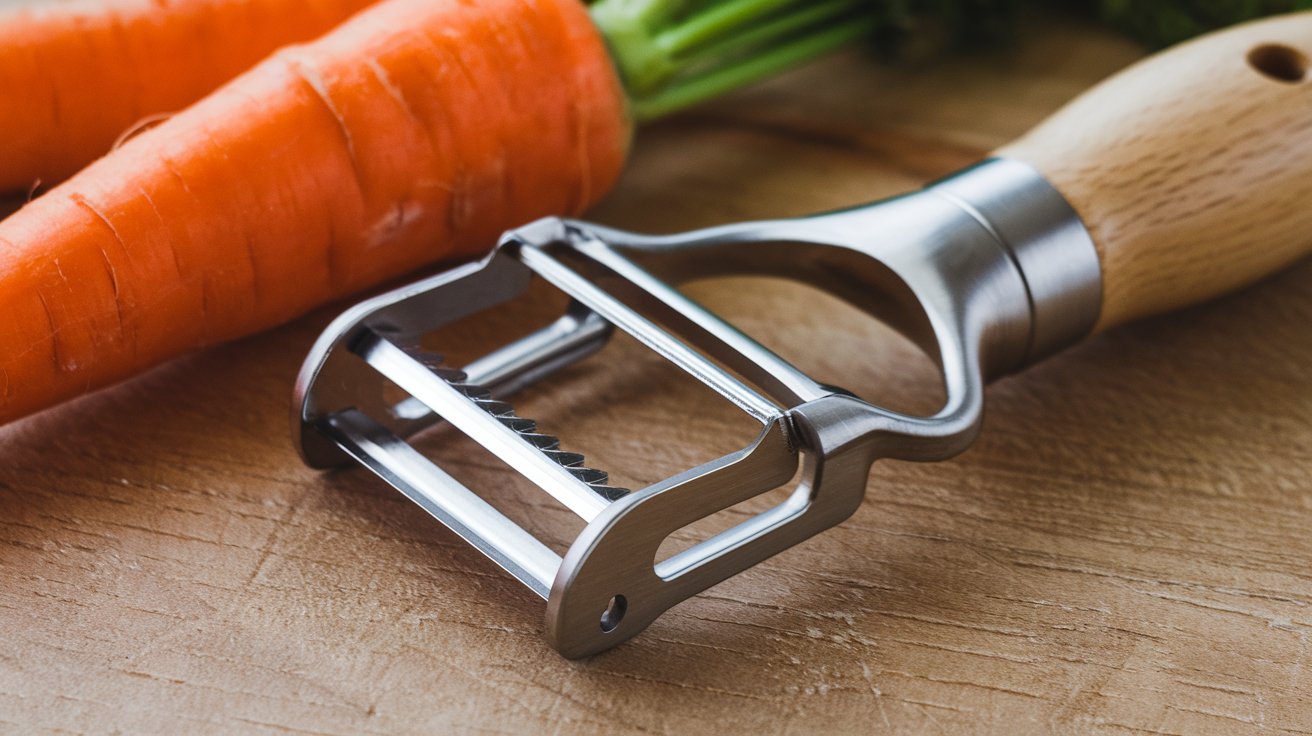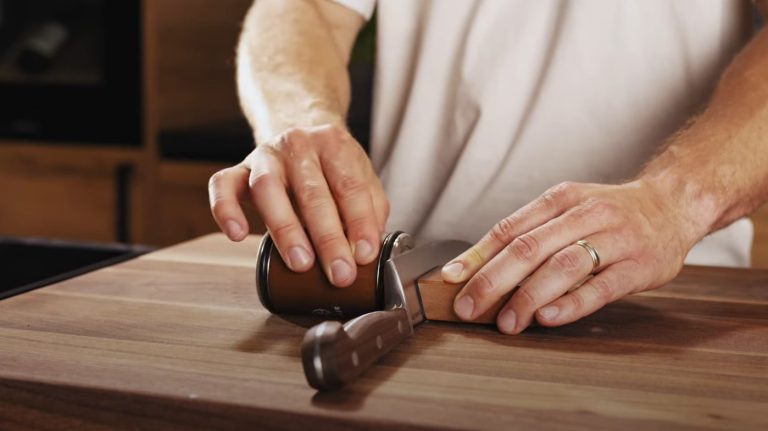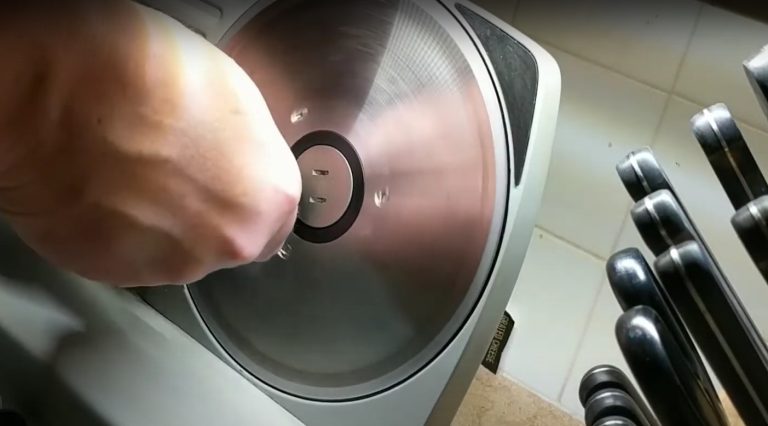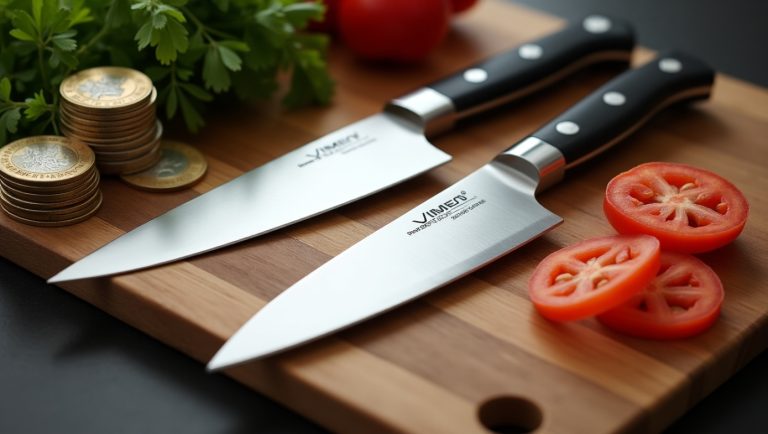How to Sharpen a Vegetable Peeler: Easy DIY Tips
To sharpen a vegetable peeler, use a honing rod or metal nail file to realign and sharpen the blade’s edge.
For better results, glide a paring knife against the blade to remove dullness or use a DMT diamond flat file for tight spots. Always wear protective gloves for safety, and maintain a clean work surface.
After use, rinse and dry the peeler to extend its life. There are additional tips to enhance your sharpening skills.
Key Takeaways
- Use a metal nail file to sharpen between the blades for effective results and to maintain the peeler’s edge.
- A honing rod can realign the blade edge, enhancing the peeler’s performance with minimal effort.
- Regularly rinse and dry the peeler after use to prevent rust and prolong sharpness.
- Wear protective gloves during sharpening to avoid accidental cuts and ensure safety.
- Store the peeler in a clean, dry place with a protective cover to maintain its condition.
Purpose of Sharpening a Vegetable Peeler
When you sharpen a vegetable peeler, you’re enhancing its efficiency, making peeling smoother and requiring less effort. A sharp peeler improves safety, as it demands less force, reducing the risk of slips and accidents.
You’ll notice greater precision, allowing for thinner strips and minimal waste during food preparation. While sharpening can extend the peeler’s life, it’s often more practical to replace it due to the low cost involved. However, if done correctly, sharpening can prove cost-effective.
A sharp peeler not only makes tasks easier but also helps maintain the texture of the vegetables by cleanly removing the skin.
Tools Required for Sharpening
To effectively sharpen a vegetable peeler, you’ll need a few essential tools that guarantee precision and efficiency. Each tool plays a specific role in ensuring your peeler regains its sharpness.
To sharpen your vegetable peeler effectively, gather essential tools that ensure precision and restore its sharpness.
Here’s what you should gather:
- Honing Rod: This tool realigns and sharpens the blade’s edge effectively.
- Metal Nail File: It’s useful for sharpening the bottom side by moving it back and forth between the blades.
- DMT Diamond Flat File: Perfect for accessing hard-to-reach areas with gentle pressure.
- Sandpaper: When paired with a piece of wood, it helps restore the peeler to better-than-new condition. Additionally, maintaining the peeler is crucial as dull blades can make peeling difficult and require more effort.
Methods for Sharpening Your Peeler
To sharpen your vegetable peeler effectively, you can use a paring knife or a metal nail file. The paring knife allows you to scrape the blade, removing any dullness, while the nail file fits neatly between the blades to sharpen both sides.
These methods are straightforward and can greatly enhance your peeler’s performance. Regular sharpening extends the life of the peeler, making it a worthwhile maintenance task.
Paring Knife Technique
Sharpening your vegetable peeler using a paring knife technique can greatly enhance its performance. This method is effective and cost-efficient, allowing you to restore sharpness without specialized tools. By using a blade-turning method, you can extend the life of your peeler as well.
Follow these steps:
- Prepare the Paring Knife: Use a dedicated paring knife for sharpening.
- Position the Peeler: Hold the peeler firmly for accessibility.
- Apply the Technique: Move the paring knife back and forth along the peeler’s blade.
- Check Sharpness: Test the peeler on a vegetable to verify it’s sharp.
Always wear gloves for safety, as this technique requires skill to avoid injury.
Metal Nail File Method
A metal nail file serves as an effective tool for sharpening your vegetable peeler, offering a simple yet efficient method to restore its edge.
This budget-friendly approach requires no specialized tools and is easy to execute. Start by cleaning and drying your peeler. Position the file at the blade’s angle, applying gentle pressure while moving it back and forth. Guarantee even sharpening on both sides for best results.
Regular maintenance is crucial because dishwashers accelerate dulling due to harsh detergents and high temperatures.
| Step | Action | Notes |
|---|---|---|
| Prepare the Peeler | Clean and dry before sharpening | Prevents rust |
| Sharpening | File along the blade edges | Maintain consistent angle |
| Maintenance | Hand wash and store properly | Regular sharpening needed |
Safety Precautions During the Sharpening Process
While sharpening a vegetable peeler, it’s vital to prioritize safety to prevent accidents and injuries. Follow these precautions to guarantee a safe sharpening process:
- Wear protective gear: Use gloves to shield your hands from accidental cuts.
- Secure your work surface: Make certain your area is stable and free of clutter to avoid slips.
- Handle tools carefully: Always grip sharpening tools firmly to prevent them from slipping.
- Position the blade securely: Keep the peeler blade in place to avoid any movement during sharpening.
Additionally, maintain good lighting to clearly see the blade edge, which helps you maintain control throughout the process.
Maintenance Tips for Prolonging Sharpness
To keep your vegetable peeler performing at its best, regular maintenance is vital. Start by rinsing the peeler under warm water after each use to eliminate debris.
Use mild dish soap and a gentle scrub brush for stubborn residues, avoiding harsh abrasives that can scratch the surface. Regular cleaning not only helps maintain hygiene but also ensures that the peeler remains efficient for a longer period.
After cleaning, dry the peeler thoroughly to prevent rust. Store it in a clean, dry location, preferably with a protective cover.
Regularly inspect the peeler for wear and apply mineral oil to metal parts to prevent rust. This lubrication guarantees smooth operation without attracting dust.
Environmental Impact of Sharpening Peelers
Sharpening your vegetable peeler not only enhances its performance but also considerably reduces environmental impact.
By maintaining your peeler, you play an essential role in minimizing waste and conserving resources. Here are some key benefits:
- Reduction in Waste: Fewer replacements mean less plastic and metal waste.
- Conservation of Resources: Extending your peeler’s life lowers the demand for new materials, especially when considering that non-toxic materials like stainless steel and wood are used in quality peelers.
- Lower Carbon Footprint: Sharpening existing tools requires less energy than manufacturing new ones.
- Minimized Pollution: Reducing discarded peelers decreases pollution from non-biodegradable materials in landfills.
Frequently Asked Questions
How Often Should I Sharpen My Vegetable Peeler?
You should sharpen your vegetable peeler based on how often you use it. If you peel frequently, aim to sharpen it every few weeks.
Look for signs of dullness, like increased pressure needed or multiple passes over the same area. Regular cleaning and drying will help maintain its sharpness.
Can I Sharpen a Ceramic Peeler?
Trying to sharpen a ceramic peeler is like attempting to mend a fragile glass—you’re likely to end up with a mess.
Ceramic blades are brittle and can chip easily, so it’s not recommended to sharpen them at home. Instead, seek professional help or consider buying a new peeler if yours has dulled.
Maintaining your ceramic peeler through careful use and proper cleaning will help prolong its life without risking damage.
Is It Safe to Use a Dull Peeler?
Using a dull peeler isn’t safe. It requires more force, increasing your risk of injury, and can lead to uneven peeling, wasting vegetables.
When the blade catches, it can cause accidents and frustration. To stay safe, always peel away from your body, keep your fingers tucked, and use a stable cutting board.
Regularly cleaning your peeler helps maintain hygiene and performance, but consider replacing it if it’s consistently dull.
What Signs Indicate My Peeler Needs Sharpening?
Ever tried peeling a vegetable only to struggle with it? If you notice difficulty peeling, increased pressure needed, or multiple passes required, your peeler likely needs sharpening.
You might also see the peel tearing instead of coming off smoothly, or the blade appearing visibly dull.
Regularly checking for these signs guarantees you maintain a functional tool, making your kitchen tasks safer and more efficient.
Keep an eye out for these indicators!
Can I Sharpen a Peeler With a Whetstone?
You can’t effectively sharpen a peeler with a whetstone. Whetstones are designed for robust blades, while peelers have more delicate designs that don’t respond well to this method.
Instead, you should use a metal nail file or a paring knife for better results. These tools are more suited for the softer materials of a peeler, ensuring you maintain its cutting edge without risking damage or ineffectiveness.
A Little Sharpening Goes a Long Way in the Kitchen
Sharpening your vegetable peeler not only enhances its performance but also prolongs its lifespan, much like tending to a garden.
Just as a well-pruned plant yields a bountiful harvest, a sharp peeler makes meal prep a breeze, cutting through skins effortlessly.
By taking the time to maintain this simple tool, you guarantee that your culinary creations flourish with ease and precision. Keep your peeler sharp, and you’ll reap the rewards in your kitchen for years to come.







